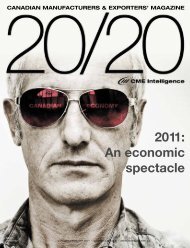The New - 20/20 Magazine
The New - 20/20 Magazine
The New - 20/20 Magazine
Create successful ePaper yourself
Turn your PDF publications into a flip-book with our unique Google optimized e-Paper software.
Voluntary push<br />
No doubt, carbon regulations are<br />
coming. Some companies will act<br />
only when compelled. But there are<br />
plenty of incentives to be proactive<br />
even without regulations.<br />
Many manufacturers are eager to<br />
put a carbon-neutral stamp on their<br />
operations and products, whether<br />
because of social responsibility,<br />
market expectations or the<br />
opportunity to ultimately save costs.<br />
In Europe, again, the public assumes<br />
a certain level of “green” in the<br />
business sector. That’s driving<br />
consumer choices and business<br />
Keep monitoring<br />
at the very least, this is the time<br />
for manufacturers to learn as<br />
much as possible about carbon<br />
and its implications – regulatory,<br />
environmental, financial and<br />
otherwise. So number one, stay<br />
current with the discussions<br />
around regulations.<br />
Number two, track how much carbon<br />
dioxide your company is emitting –<br />
anything produced by a particular<br />
activity at a particular point in time,<br />
using tools from smokestack<br />
monitoring to computer accounting<br />
programs. With the right software,<br />
you can track the carbon footprint of,<br />
say, a tire, from Malaysia where the<br />
latex was tapped, to the plant where<br />
the tire was made, to the destinations<br />
where it arrived by ship or train.<br />
Number three, keep an eye on what<br />
your competitors are doing too. and<br />
number four, keep your ears open to<br />
what customers are expecting.<br />
actions on emissions. This mindset<br />
seems to be gaining momentum in<br />
North america.<br />
Managing carbon starts with getting<br />
an objective, comprehensive method<br />
of quantifying your carbon footprint.<br />
Usually this is measured in three<br />
different scopes:<br />
n direct emissions that you control,<br />
i.e. arising from your operations.<br />
n Indirect emissions from consuming<br />
purchased energy, e.g. electricity,<br />
steam, fuel.<br />
n other indirect emissions, i.e.<br />
incurred by suppliers and<br />
transportation-related activities.<br />
I know one company that has decided<br />
to take positions in the carbon offsets<br />
market, not because of compliance or<br />
any commitment to reduce emissions,<br />
but simply to educate themselves – to<br />
see how the carbon markets and the<br />
registries work and to track a specific<br />
carbon credit. In short, they want to be<br />
ready for the day when they might have<br />
to be active in the emissions market.<br />
Carbon regulations on your sector may<br />
have a direct impact on your company.<br />
But manufacturers need to prepare for<br />
other types of impacts.<br />
Perhaps when carbon legislation<br />
is enacted, it won’t apply to your<br />
manufacturing segment. But your cost<br />
of energy may rise, and that certainly<br />
will affect you and may change how<br />
you run your plant. regulations may<br />
be in limbo, but in the meantime your<br />
competitors may be mounting an<br />
aggressive green campaign that may<br />
affect you too.<br />
<strong>The</strong> first two categories are the<br />
most straightforward, looking at the<br />
emissions factor from your operations<br />
and energy consumption. <strong>The</strong> third<br />
category is more complex, and is partly<br />
based on suppliers doing their own<br />
environmental accounting.<br />
It’s encouraging to see initiatives<br />
like the Carbon disclosure Project<br />
(www.cdproject.net), where<br />
organizations measure and report<br />
their GHG emissions. More and more<br />
are doing so, and a higher percentage<br />
of Canadian manufacturers and other<br />
firms now see opportunities around<br />
carbon reduction rather than risks.<br />
Many manufacturers have<br />
demonstrated that it’s possible to<br />
achieve greater efficiency and increase<br />
production, all while reducing their<br />
carbon footprint. <strong>The</strong>se experiences<br />
should motivate others as the need to<br />
control carbon becomes one of the<br />
biggest environmental and business<br />
issues facing manufacturers.<br />
For more tips and tools on greening<br />
your business, visit our advice centre<br />
at rbc.com/business-advice.<br />
<strong>The</strong> strategies, advice and technical content in this publication are<br />
provided for the general guidance and benefit of our clients only. This<br />
publication is not intended to provide specific financial, investment,<br />
tax, legal, accounting or other advice for you, and should not be relied<br />
upon in that regard. Readers should consult their own professional<br />
advisor when planning to implement a strategy to ensure that<br />
individual circumstances have been considered properly and it is<br />
based on the latest available information.<br />
® Registered trademarks of Royal Bank of Canada. RBC and Royal Bank are registered trademarks of Royal Bank of Canada.



